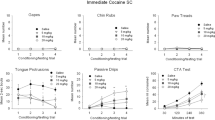Abstract
An experiment was conducted to test whether centrally acting drugs could act as conditioned stimuli (CS) in a classical conditioning paradigm in which electric shock acted as the unconditioned stimulus (US) and suppression of drinking was used as an indicator of a conditioned response (CR). Thirsty rats were allowed to drink water during daily classical conditioning sessions which took place in their home cages. The CS was either a drug injected before the session or a “cocktail” of sensory stimuli (light+tone+vibration) turned on at the beginning of the session. Part way through some sessions the animals received electric foot shock as the US. Two different drugs and the sensory cocktail were used as CSs in a discriminated classical conditioning paradigm in which one drug or stimulus (the CS+) predicted the subsequent occurrence of shock, and the other two conditions acted as CS− stimuli and predicted absence of shock. After an average of 5.7 pairings of the CS+ with shock, conditioned suppression of drinking was observed; the CR occurred only during tests preceded by the CS+ drug or stimulus. At one time or another during the experiment, pentobarbital, phencyclidine, morphine, and pentylenetetrazol were employed as the CS+. Each acquired the ability to elicit a CR, although pentobarbital was noticeably less effective than the other three drugs. All conditioning trials took place in hanging metal cages, but the CR generalized into plastic cages with sawdust floors. Each rat received three successive phases of conditioning with a different CS+ condition employed in each phase; each phase of conditioning was followed by extinction of the CR. Speed of acquisition and speed of extinction of the CR remained relatively uniform across successive phases. The results suggest that centrally acting drugs can act as conditioned stimuli in a classical conditioning paradigm when suppression of drinking is used as the CR.
Similar content being viewed by others
References
Carey RJ (1989) Stimulant drugs as conditioned and unconditioned stimuli in a classical conditioning paradigm. Drug Dev Res 16:305–315
Commissaris RL, McCloskey TC, Damian GM, Brown ED, Barraco RA, Altman HJ (1990) Antagonism of the anti-conflict effects of phenobarbital, but not diazepam, by the A-1 adenosine agonist 1-PIA. Psychopharmacology 102:283–290
Eikelboom R, Stewart J (1982) Conditioning of drug-induced physiological responses. Psychol Rev 89:507–528
Flaten MA, Grawe RW, Dahl CB, Haug T (1991) Aversive and compensatory classical conditioning with diazepam as a conditional stimulus. Scand J Psychol 32:70–78
Jaeger TV, Mucha RF (1990) A taste aversion model of drug discrimination learning: training drug and condition influence rate of learning, sensitivity and drug specificity. Psychopharmacology 100:145–150
Lett BT (1986) Conditioned slowing of stomach emptying produced by Pavlovian pairings of a drug CS or place with lithium chloride. Psychopharmacology 90:49–53
Mastropaolo JP, Moskowitz KH, Dacanay RJ, Riley AL (1989) Conditioned taste aversions as a behavioral baseline for drug discrimination learning: an assessment with phencyclidine. Pharmacol Biochem Behav 32:1–8
Overton DA (1982) Comparison of the degree of discriminability of various drugs using the T-maze drug discrimination paradigm. Psychopharmacology 76:385–395
Overton DA (1984) Differential conditioning can reverse the fear-reducing effects of phenobarbital. Bull Psychon Soc 22:73–76
Overton DA, Leonard WR, Merkle DA (1986) Methods for measuring the strength of discriminable drug effects. Neurosci Biobehav Rev 10:251–263
Schmidt H, Dry L (1963) Dose and time as variables in barbiturate action upon water ingestion. Am J Physiol 204:817–820
Schmidt H, Moak SJ (1959) Some drug effects influencing barbiturate facilitation of water ingestion. Am J Physiol 196:307–314
Silverman PB (1990) Classically conditioned ethanol stimulus control of a motor behavior. Alcohol 7:489–492
Turner EG, Altshuler HL (1976) Conditioned suppression of an operant response usingd-amphetamine as the conditioned stimulus. Psychopharmacology 50:139–143
Wilken LD, Cunningham CL, Fitzgerald RD (1982) Pavlovian conditioning with ethanol and lithium: effects on heart rate and taste aversion in rats. J Comp Physiol Psychol 96:781–790
Author information
Authors and Affiliations
Rights and permissions
About this article
Cite this article
Overton, D.A., Shen, C.F. & Tatham, T.A. Centrally acting drugs act as conditioned stimuli in a conditioned suppression of drinking task. Psychopharmacology 112, 270–276 (1993). https://doi.org/10.1007/BF02244921
Received:
Revised:
Issue Date:
DOI: https://doi.org/10.1007/BF02244921




